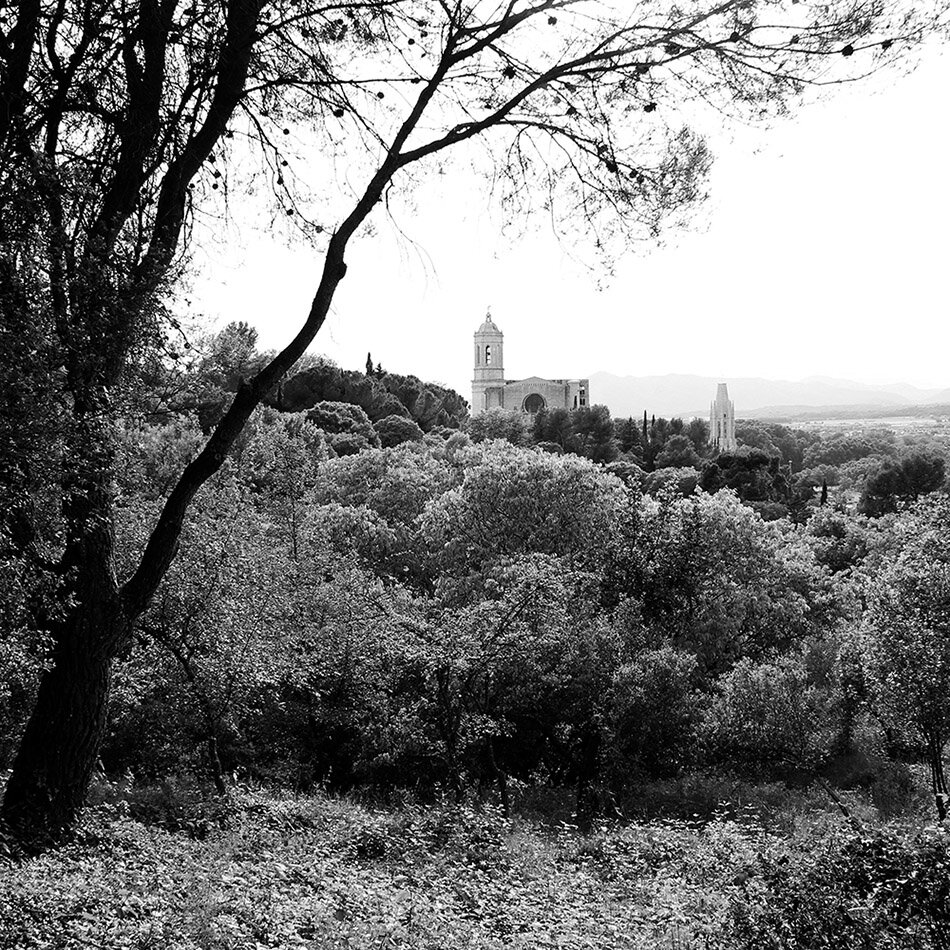WITH DIFFERENT EYES - GIRONA SHORES
girona shores
Client: Ajuntament de Girona
Landscape Architects: Estudi Martí Franch
Collaborators: Brigada Municipal
Project Area: 600ha (between 2014-2019: 45ha)
Project Date: 2014 - ongoing
THE PURSUIT OF A NEW AESTHETIC FOR THE PERI-URBAN LANDSCAPE THROUGH FLEXIBLE AND RESPONSIVE DESIGN
It is the end of spring, and with the arrival of the Mediterranean summer, the lush green meadows on the hilly outskirts of Girona will soon change colour. Until recently, these peri-urban spaces had been neglected and misused as a dumping ground. But Girona, a town in Northern Catalonia with a population of almost 100 000 inhabitants, is growing due to its proximity to Barcelona. And with the increasing population density, high-quality open spaces around town have become scarce.
Landscape architect Martí Franch, using his profound knowledge of the city, the surrounding landscape and the local bureaucratic structures, recognized the potential of the peri-urban natural spaces. His goal: to weave the so far largely inaccessible and abandoned green areas on the periphery of the city into a multifunctional open space structure.
He persuaded the city council to put its Brigada or brigade - the landscape maintenance team – at his disposal for the first interventions. The brigade, and in particular their practical and site-specific knowledge and enthusiastic commitment, would play a central role in the further course of the project. The city council did not mind, as there were no additional costs involved. And Franch found important allies within the administration to start the first two pilot projects - one along the riverbanks and the other in the hills outside of town.
General Plan
A CONVERSATION WITH THE LANDSCAPE
The project for the regeneration of the peri-urban landscape of Girona started five years ago. With no budget at all, but the support of the brigade, Martí Franch and his team got down to work. The particular focus of their methodology includes a detailed examination of the landscape, topography, the specific ecological and seasonal processes. Concepts are being developed while moving through the landscape, a process Franch calls "drawing a path by walking as if only the feet could see". The landscape itself turns into the drawing board; ideas are being implemented directly on site. According to Franch, the interventions are intended to simply highlight the peculiarities of the landscape. He compares his work with that of an editor or curator who "edits" the landscape. For the pilot project along the banks of the River Ter, a former beach was freed from wild growth and made accessible again. The inspiration for this direct exchange with nature and landscape, and the dynamic and context-specific approach were, among others, projects by French landscape architects Gilles Clément and Alexandre Chemetoff.
SEEING WITH DIFFERENT EYES
Though the landscape architects, the city council's ecologists and the brigade are driving the project, there are no clearly defined roles. Potential sites, their characteristic qualities and planned interventions are discussed and implemented as a collective. Martí Franch and his team also join in to help on the ground – you might see him on the weekend walking around the outskirts of Girona, his pruning shears at hand. At the same time, the ecologists and members of the Brigada are involved in the design process.
Each intervention begins with a - in some instances radical - clearing of the vegetation, the pruning of trees and mowing of meadows. New visual axes, connections and a network of paths are created. Terraces and other traces of previous cultural landscapes are uncovered. Where once thick scrub covered the ground, new spaces emerge, and daylight passes through again. A different dynamic is initiated, and diverse vegetation structures can now unfold. A new aesthetic for the peri-urban landscape is what Martí Franch aims for, so people will "see it with different eyes", build a new relationship with it, and ultimately, care about it.
One of the most unusual aspects of the Girona project is its sequence of phases. The implementation of the pilot projects took place before the development of a comprehensive strategy. Plans and diagrams are not produced to build the design, but to document and disseminate the acquired knowledge. There is no traditional master plan. Rather, it is a flexible, strategic document that is updated on an ongoing basis according to the latest findings and provides a guide for future interventions. The development of an overall strategy, the concept design, maintenance management and punctual interventions are being carried out at the same time.
DIFFERENTIATED MANAGEMENT DESIGN
The most important design tool is the site-specific and continuous regime of care for the green open spaces. While certain areas are regularly mowed and cleared, others are left to grow. This destabilization of the existing ecosystem generates a mosaic of different stages of succession. Highly effective spatial structures are created with minimal effort. At the same time, the clearings reveal many astounding local plant species and magnificent specimens of native maples (Acer monspessulanum) and downy oaks (Quercus humilis).
The Differentiated Management Design consists of several methods: the removal, adaptation and correction of the vegetation. Although a continuous long-term maintenance management is essential, these interventions are characterized in particular by their spontaneous and rapid implementation, as well as their direct impact on the spatial structures and perception of the landscape.
Though where and when to intervene? All involved actors are in constant contact. New sites for potential intervention are discussed and decided on an individual basis. Sometimes the brigade sets out on its own and implements interventions based on the jointly developed strategy.
AREAS OF TENSION
Any open-ended process is operating in an area of tension. Can landscape architects leave design decisions to others? To what extent can you interfere with nature, and what is the impact on the status quo? Which stages of succession to preserve? How radical should the interventions be? Every single decision is a balancing act.
Its flexibility, however, is also one of the greatest strengths of the project, as is the minimal budget required and the use of existing resources. It facilitates the upscaling, knowledge transfer and implementation in other cities and regions. The strategy is extremely adaptable and can respond directly to changing circumstances. This aspect is particularly important in relation to climate change adaptation. In Girona for example, the Differentiated Management Design has also been applied for forest fire prevention.
A fundamental aspect to achieve a high-quality result though, Franch emphasizes, is the ongoing collaboration of main actors, benefitting this way from each other's core expertise - the landscape architect’s spatial thinking and design skills, the ecologist’s scientific knowledge of ecological processes, and the practical know-how and specific site knowledge of the brigade.
It is no coincidence that such an ambitious project – the execution of a large-scale green space strategy with virtually no budget - has emerged in southern Europe. The country is still haunted by the economic crisis, and construction - especially in the public domain - has largely come to a halt due to austerity measures. With his Girona Shores project, Marti Franch therefore wants to achieve maximum effect with minimal resources, since the removal and not the addition of elements is the most important feature of this strategy.
APPROPRIATION
Five years after the brigade first set out to clear the vegetation in the pilot areas, the various interventions and stages of succession in the peri-urban spaces of Girona are clearly visible. Eventually, the new open space structure will connect approximately 600 hectares of green spaces in the periphery of Girona, with a particular focus on creating new open spaces for marginalized and underserved neighbourhoods.
The appropriation of the newly created green spaces by the residents is an ongoing process as well. Although just a few neighbours can be seen taking a walk on this mild evening in May, Girona's citizens are slowly discovering this hidden gem on their doorstep. Empty beer bottles, love letters and cocktail recipes carved into the wooden benches are evidence that local residents are starting to appropriate these previously inaccessible spaces.
Images © EMF & Sigrid Ehrmann
This article is an adapted version of my article published in German in Garten+Landschaft.










